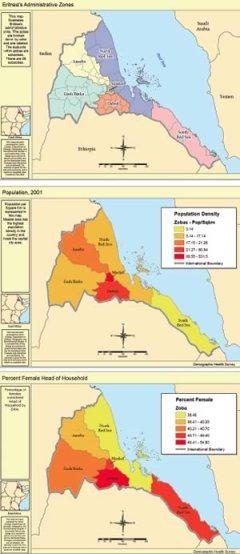Calvin students create national atlases

Students in a Calvin geography class have created online national atlases for Eritrea, Thailand and Nepal with more on the way. The project benefits the Calvin students but also has the potential to make a difference in the lives of students in those countries.
“Most developing nations do not have the capacity to produce national atlases,” said Calvin geography professor Jason Van Horn. “As a result, students (in developing nations) lack a comprehensive resource to thoroughly investigate their own country.”
Van Horn, who joined the college’s faculty in 2007, is a geographic information system (GIS) expert with a PhD from Ohio State University. He said that GIS is simply a way to present data visually, often using maps.
To create the online atlases, each Calvin student in Geography 222 completed a small number of maps using a standard mapping atlas template. The maps are assembled and posted online to form a complex atlas for the country. Van Horn said the Calvin classes have thus far highlighted countries that have heretofore not been represented in this way online.
A national atlas usually has general reference and thematic maps, often several hundred maps. Themes cover not only physical geography, but also visually represent such things as population density, monthly income per household, number of students attending school, religious distribution, even how many dentists a country has, where registered vehicles are located, crime statistics and much more.
“(It’s) almost everything you’d want to know about a particular country,” said Van Horn.
Students who have been involved in Calvin’s GIS courses—and the atlas project—said it’s been a satisfying way to put classroom learning into practical applications.
Andrew Quackenbush, a senior geography major and international development minor from Naperville, Ill., said it felt good to be part of something that will make a difference for years to come.
“It could turn into a viable learning resource for not only those at Calvin, but for anyone,” he said. “It would also be great if somehow these countries could utilize it in their education. I am really excited to see where this project is years from now.”
Quackenbush said the interdisciplinary nature of the project makes it interesting and relevant across the Calvin campus.
“GIS can be used in so many different fields of study,” he said. “The atlas project is very good at addressing all different sorts of studies in relation to a specific country. For example it deals with economics, geography, political science. I would be surprised if there was a major at Calvin that couldn’t be tied in with this project somehow.”
To create their detailed national atlases, Van Horn’s charges use specialized GIS software called ArcGIS. Because the information is shown visually, it can be shared and understood in a different way than if it were presented as numbers or raw data. The software Calvin uses is an industry standard, the same software students will use when they graduate and work in one of the many fields that employ GIS specialists.
Van Horn said GIS and geospatial information has been identified as a high-growth industry by the Career Voyages Program, a collaboration between the U.S. departments of Labor and Education. GIS graduates are working nationwide in varied industry sectors (at companies such as AT&T, Lockheed Martin, the Gap and Sara Lee), plus city, county and state governments. GIS and global positioning system (GPS) also are at the heart of cell phone initiatives, new Facebook services, Foursquare and other social media that use location as a feature of their service.
“Although I have been involved with GIS now for a few years, there are still tons of things that I don’t know how to do,” Quackenbush said. “Professor Van Horn is really great about letting students learn as much as possible and wants to challenge them. And he is very personable. I have never seen a professor give so much care to making sure his students understand the material. He relates very well to all students and cares about them in a very Christian way.”
Van Horn shrugs off such effusive praise, deflecting it back to his students.
“Andrew has taken this project to the next level, and the students in the classes have been great,” he said. “For me to be at Calvin is something I never thought possible. I figured after graduate school that I would be at a big research university and try to impact students as best I could. To be able (at Calvin) to work closely with really good students and still do my research is the opportunity of a lifetime. And to be able to engage the world with things like the atlas project is what Calvin is all about.”






